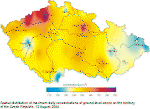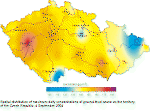|
|
AIR POLLUTION IN THE CZECH REPUBLIC IN 2004 Czech Hydrometeorological Institute - Air Quality Protection Division |
|
|
|
|
2.3. Evaluation of the smog regulation systems operation on the territory of
the Czech Republic in 2004
January and February 2004 had significant differences as concerns temperatures. The average monthly temperature in January was ‚Äď3.9 įC with the deviation ‚Äď1.1 įC from the normal, the February average temperature reached 0.4 įC with the deviation +1.5 įC. November and December were slightly above normal, the November average monthly temperature was 3.2įC with the deviation from the normal +0.5 įC and December had the average monthly temperature ‚Äď0.8 įC with the deviation from the normal +0.2įC. The above-normal temperatures in February 2004 resulted from the creation of the leading anticyclone of 1035 hPa above the Mediterranean Sea, when from 1 to 8 February 2004 warm air from south-west came above the territory of the Czech Republic along the northern edge of the anticyclone. According to the measurements of the station Prague-LibuŇ° the long-term normals were exceeded by 8‚Äď13 įC. The positive deviations from the long-term normal were broken on 11 February when cold air from the north spread above the territory of the Czech Republic on the front side of other anticyclone. The total precipitation in January, February and November was markedly above normal, the deviation ranged between 130‚Äď171 %. December was markedly subnormal, with the monthly total precipitation of 24 mm, which represents 49 % of the normal. In January 2004 the anticyclonic situations occurred in 45 % of cases, in February, November and December 2004 they covered 57‚Äď63 % of the respective monthsí length. The longest anticyclonic period (13 days) occurred from 4 to16 December 2004. From 4 to 7 December the anticyclone of 1025 hPa with the centre above the British Isles reached the central Europe and later the eastern Europe and the territory of the Czech Republic was influenced by the decaying southern edges of cold fronts. From 8 to 16 December 2004 the anticyclone centre with the value ranging between 1030 and 1035 hPa moved across Bohemia, Slovakia and the Carpathians to Austria, where it remained from 11 to 14 December 2004. In the following two days it moved to the Ukraine and the Carpathians. On 16 December the cold front spread into central Europe and the anticyclonic character of the weather was thus finished. For the whole period the frontal disturbances were moving towards the north, across the British Isles above Scandinavia to the Ural area, later above the Barents Sea. In spite of the fact that there were recorded meteorological situations with unfavourable dispersion conditions suitable for increasing pollutants concentrations, the smog situation did not occur in the monitored period and it was not necessary to issue the signals within the Smog Warning and Regulation System. Nevertheless, there occurred individual cases of SO2 concentrations exceedance above 250 őľg.m-3, e.g. at the station Mńõdńõnec the short-time value reached 301 őľg.m-3. From 20 to 22 December 2004 the territory of the Czech Republic was influenced by the anticyclone and high concentration of PM10 suspended particles were measured on the whole territory of the Czech Republic, with the highest values in Lom (542 őľg.m-3) and in VńõŇôŇąovice (555 őľg.m-3). The nitrogen dioxide concentrations higher than 200 őľg.m-3 occurred on 25 days at the traffic station Prague-Legerova in total duration of 121 hours, which represents 3.7 % of the monitored period. On 15 February 2005 at 8:00 UTC the maximum hourly concentration at the Prague-Legerova station reached 349 őľg.m-3 (Figs. 2.3.1, 2.3.2). In most cases the concentrations of the pollutants decreased very quickly, and the conditions for the Smog Warning and Regulation System signals to be issued were not fulfilled. Ozone is a typical secondary pollutant, created in the atmosphere under the influence of solar radiation on nitrogen oxides and VOCs. Initial substances of the complex chemical reactions resulting in ground-level ozone creation are called precursors. More than 50 % of ozone precursors are represented by air pollution from traffic. Optimal meteorological conditions for the creation of ground-level ozone, i.e. intensive solar radiation, high temperatures and calm weather or light wind, occur in anticyclonic situations in summer periods. In the warm period from 1 April to 30 September cyclonic situations were markedly prevailing (in 69 % of cases). The majority of anticyclonic situations occurred in September (they covered 43 % of the period), in April (40 %), in June (37 %) and in August (32%); only 13 % cases with anticyclonic character of the weather occurred in July. The most frequent situations were anticyclonic situations lasting for 1‚Äď3 days. There were three situations lasting for 7‚Äď10 days, and namely in June, August and September. The meteorological station in Prague- LibuŇ° reported the maximum measured daily temperature 34.2įC on 12August 2004 (Fig. 2.3.3). The analysis of meteorological situations shows that in the period between 1 April and 30 September 2004 the conditions for the creation of ground-level ozone were not favourable enough. Within the monitored period the alert threshold limit of 180 őľg.m-3 was exceeded on two days at the AIM stations, but not in three subsequent hours. Consequently, it was not necessary to issue any signal within the Smog Warning and Regulation System. The first case of increased concentrations of the ground-level ozone occurred on 12August 2004. Within the indistinctive higher pressure area weak occluded front was decaying above the central Europe. In the front side of the cyclone of 1000 hPa with the centre above the Bay of Biscay the inflow of warm air from southwest to the central Europe culminated. The cold front above western Europe moved to the east and during the night hours was crossing over the territory of the Czech Republic. In the morning of 12August 2004 the weather was almost clear, the afternoon was somewhat cloudy, the night was cloudy to overcast with storms and showers. The afternoon maximum temperatures reached to 30‚Äď34 įC in Bohemia, in Moravia to 28‚Äď32 įC. The velocity of the wind, blowing from the south in the morning and in the afternoon from the east, did not exceed 3 m.s-1. During the night the wind got up to 4‚Äď7 m.s-1 and veered to the west. The majority of the territory recorded the night precipitation totals from 10 to 20 mm, in eastern Bohemia up to 40 mm. Beginning from 7 August the majority of the Czech measuring stations recorded the gradual increase of ground-level ozone concentrations from the values of about 120 őľg.m-3 up to 197 őľg.m-3 in LitomńõŇôice on 12August 2004. The concentrations measured on this day reached 182‚Äď197 őľg.m-3 at 5 stations in the Central Bohemian Region and at further 16 stations located throughout the Czech Republic, with the exception of the Moravian-Silesian Region, to 161‚Äď178 őľg.m-3 (Fig. 2.3.4). On the following day, after the of the cold front passage, the ground-level ozone concentrations markedly decreased on the whole territory of the Czech Republic to the values between 70 and 90 őľg.m-3. The second episode of the increased ozone concentrations occurred as late as early September. The weather in central Europe was influenced by the ridge of higher pressure, stretching from the Azores across western and central Europe to the area of the Barents Sea, where there was the ground-level centre of the anticyclone of 1030 hPa. On the front side of this ridge cold air from the north entered above the northeastern part of Moravia. In Bohemia and southern Moravia advection of warm air remained temporarily on the front edge of the cyclone of 990 hPa with the centre above Island. The whole day of 4 September the weather was almost clear with maximum temperatures of 24‚Äď28 įC. The prevailing northern winds reached 2‚Äď5 m.s-1. From 31 August to 4 September the ground-level ozone concentrations on the whole territory of the Czech Republic were gradually increasing from the values about 100 őľg.m-3 up to 194 őľg.m-3 at the station PlzeŇą-Vinice on 4 September 2004. The values of 176‚Äď187 őľg.m-3 were measured at further three stations in PlzeŇą on the same day. Concentrations between 160 and 170 őľg.m-3 were recorded also at three stations in Prague, in Brno, Mikulov- Sedlec, Jihlava, T√°bor and Kladno. (Fig. 2.3.5). On the following day the ground-level ozone concentrations decreased to 90‚Äď130 őľg.m-3 in Bohemia, and to 70‚Äď110 őľg.m-3 in Moravia. Fig. 2.3.1 Average hourly NO2 concentrations at the station Prague 2-Legerova, 1. 1. 2004‚Äď29. 2. 2004 Fig. 2.3.2 Average hourly NO2 concentrations at the station Prague 2-Legerova, 1. 11. 2004‚Äď31. 12. 2004 Fig. 2.3.3 Course of maximum daily temperatures, their normal and daily total precipitation at Prague-LibuŇ° station. Occurrence of ozone concentrations exceeding 180 őľg.m-3 on the territory of the Czech Republic, 1. 4. 2004‚Äď30. 9. 2004 Fig. 2.3.4 Spatial distribution of maximum daily concentrations of ground-level ozone on the territory of the Czech Republic, 12August 2004 Fig. 2.3.5 Spatial distribution of maximum daily concentrations of ground-level ozone on the territory of the Czech Republic, 4 September 2004
|




